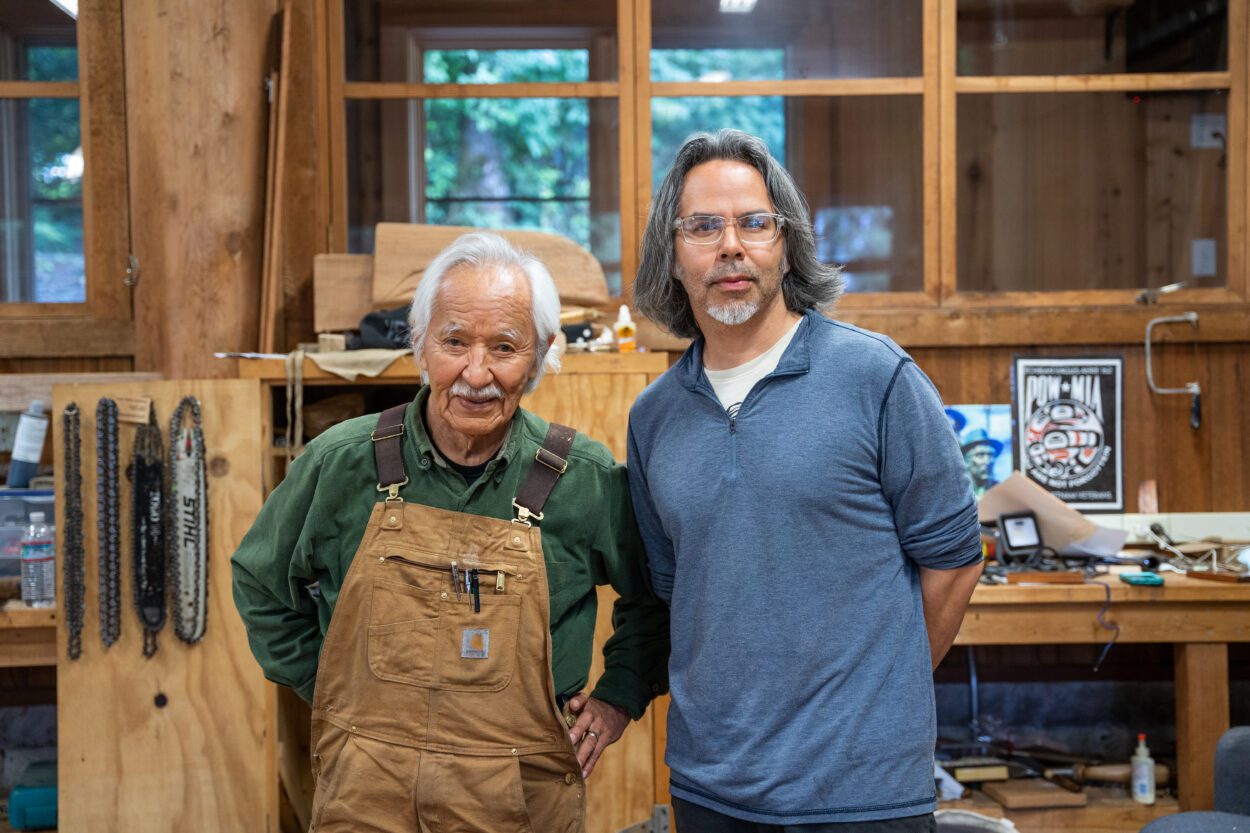
Nathan Jackson and his son Stephen Jackson, who uses the artist name Jackson Polys, stand in the carving shed in Saxman earlier this month. (KRBD photo by Eric Stone).
Two totem poles bound for Sealaska Heritage Institute’s Totem Pole Trail in Juneau will be from the carving shed of Ketchikan artists. Renowned Tlingit master carver Nathan Jackson, his son Stephen Jackson — who uses the artist name Jackson Polys — and four apprentices will be done by year’s end.
The smell of cedar fills the carving shed in Saxman. Tourists chatter and snap pictures, watching and listening to master carver Nathan Jackson as he works his craft on a 25-foot log. In another part of the shed, behind closed doors, his son Jackson Polys has spread out sketches of his own pole, being carved nearby.
Both poles are being created for the Totem Pole Trail in Juneau – father working on one, and son on the other, with apprentices helping out.
It won’t be the first time that work from the Jackson family makes it to Juneau. Polys created one of the bronze house posts standing in front of the Sealaska Heritage Institute’s building. Jackson has poles standing outside Juneau-Douglas High School and in numerous places around the state. His work has been featured in exhibits and magazines both in Alaska and nationwide.
Polys’ pole focuses on the Shangukeidi clan.
The pole is topped by the figure of a Thunderbird.
“Another figure, another story, on this pole is the house lowered from the sun crest,” Polys said. “There were wars with Tsimshian people that Shangukeidi were decimated.”
That tells the story of a mother and daughter who are the last of their clan. To save the clan, the mother marries the sun.
There’s also a spirit bear on the pole — “Who led Ḵaax̱’aatee, Shangukeidi shaman and leader down a glacier path during the Little Ice Age, which is like (the year) 1550 to 1900,” Polys noted.
Polys said that the bear in the story could have been a cross between a polar bear and a grizzly.
The lower figure on the pole takes inspiration from the history of a military leader named Fredrick Schwatka, who led explorations into the Yukon area. Polys said that the man did not pay a debt he owed so the clan took his name and military uniform.
Carving the pole isn’t a job that is being taken lightly.
“So the story is kind of given to the carvers (by SHI) and in some cases, it’s more set, but a lot of times, there’s a lot of back and forth between the artist, the carvers, and the oral historians, (who) are caretakers of the culture, to ensure that (it) is a piece of art, ultimately, that is respectful of both those aspirations,” Polys shared. “To have that story recorded, and also to ensure that it has certain visual characteristics that are exemplary of, like, high or valuable Northwest Coast Native art.”
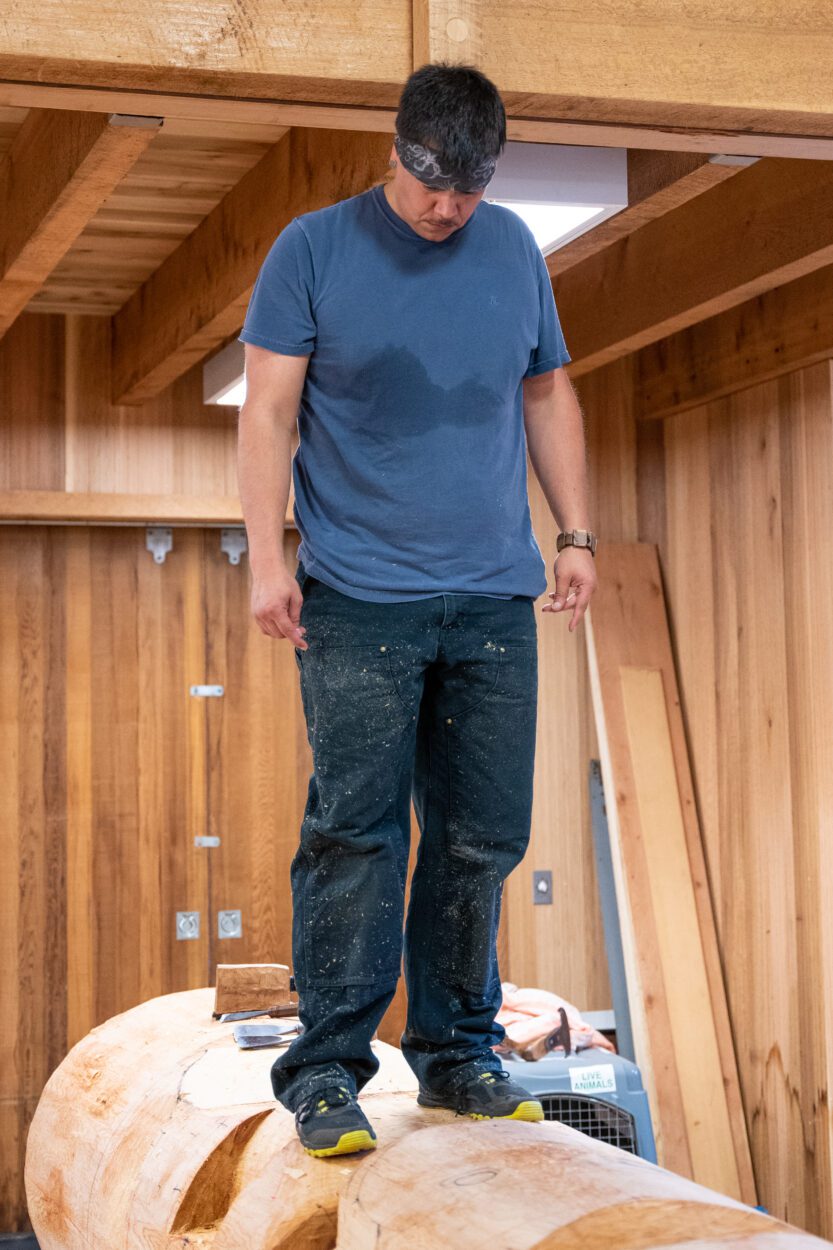
Christian Dalton, a carving apprentice working with Nathan Jackson and Jackson Polys, stands on top of the pole in progress. (KRBD photo by Eric Stone).
Nathan Jackson’s pole symbolizes the Wooshkeetaan clan. The first figure on the pole is an eagle, and the second, a mountain. He said he wasn’t quite sure at first why the mountain was to be on the pole. But he learned that the clan would put a pole in the ground over a cache of frozen meat.
“And so that was the reason why they actually did a totem pole and put it right there, to lay claim to that place where they put the meat, so nobody would bother it and so it was a freezer,” Jackson said.
Below the mountain is a shark. Jackson said he thought maybe it was a salmon shark, but it was actually a great white, said to have gone after people in canoes.
The shark first came after two young boys in a canoe.
“I don’t know where they were going or what they were doing,” Jackson added. “But when the shark came up it noticed perhaps a little canoe. Like it was the shape of a seal.”
It happened again with a canoe carrying two young men.
“So they decided what they were going to do and how they were going to do it,” Jackson said.
They ended up taking the big canoe and taking two small canoes,” explained. “And the young fellows that were aboard the bigger canoe were crack shots with the bone arrow. And so they ended up, soon as the shark came up … they got him with a bow and arrow.”
The shark was brought back to the shore as evidence, and Jackson says a clan elder decided it would be used as a clan crest from then on out.
Both Jackson’s and his son’s pole should be done by the end of the year. He said it’s been easy working alongside his son.
“I think one of the things that’s really good is you know, we can understand each other,” Jackson said about working alongside his son. “We’ve done it before.”
Working with Jackson and Polys are three apprentices – Took, Christian Dalton, and Norman Natkong.
Took’s legal name is Raymond Gregory. He is Deisheetaan (Lingit) and Deg Hit’an (Dene). His family is from Angoon but he grew up in Juneau.
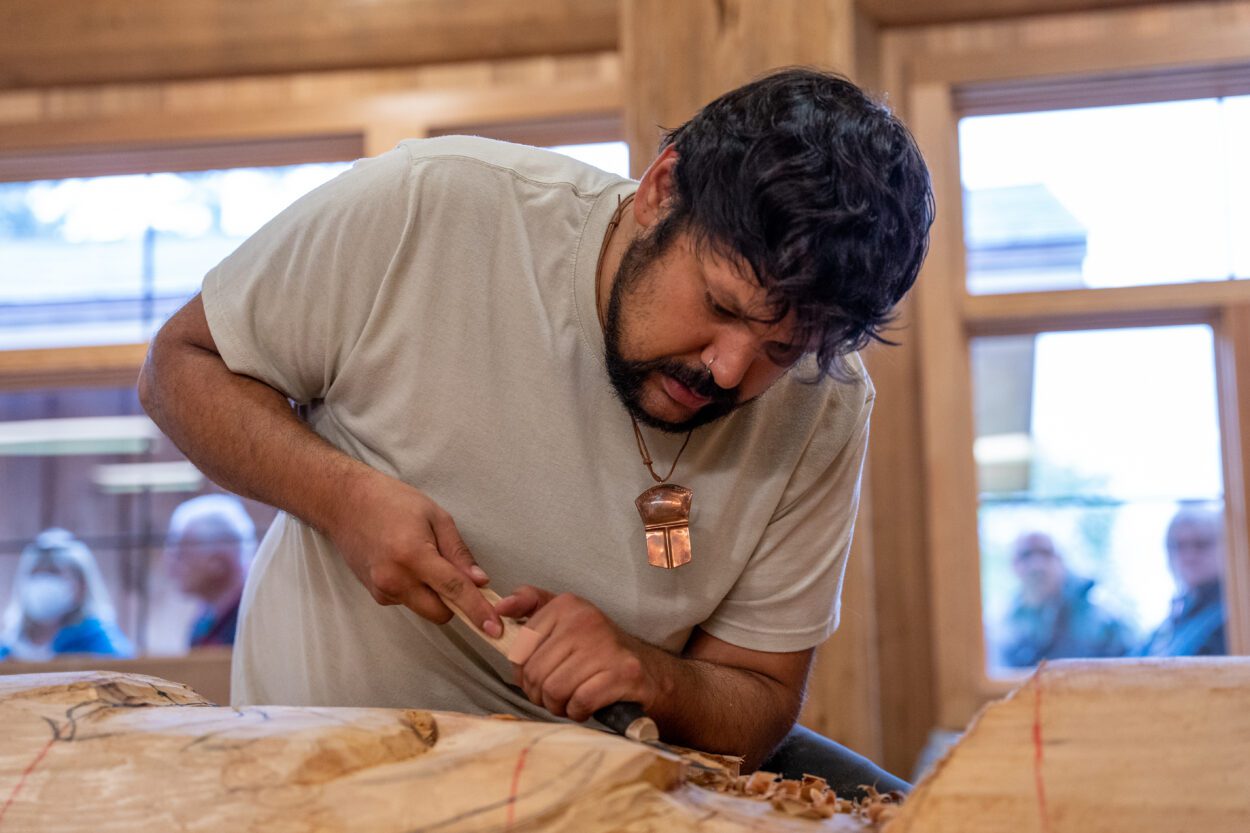
Took works on a pole that will be raised for Sealaska Heritage Institute’s Totem Pole Trail. (KRBD photo by Eric Stone).
Took has been carving for about five years. He is carving the bear’s face on Polys’ pole.
“Like, Stephen and Nathan Jackson are, you know, legendary, right?” he said. “It’s an honor.”
Norman Natkong used to do presentations at the carving shed and was a member of the Cape Fox dancers. He didn’t take too much interest in carving as a kid. Natkong is Haida on his father’s side and Coast Salish on his mother’s side. He was born and raised in Saxman.
“But as I got about 21, I took more interest and I started doing little poles here with Nathan, and I’ve known Nathan my whole life. He comes over (and) watches UFC fights and stuff,” Natkong said.
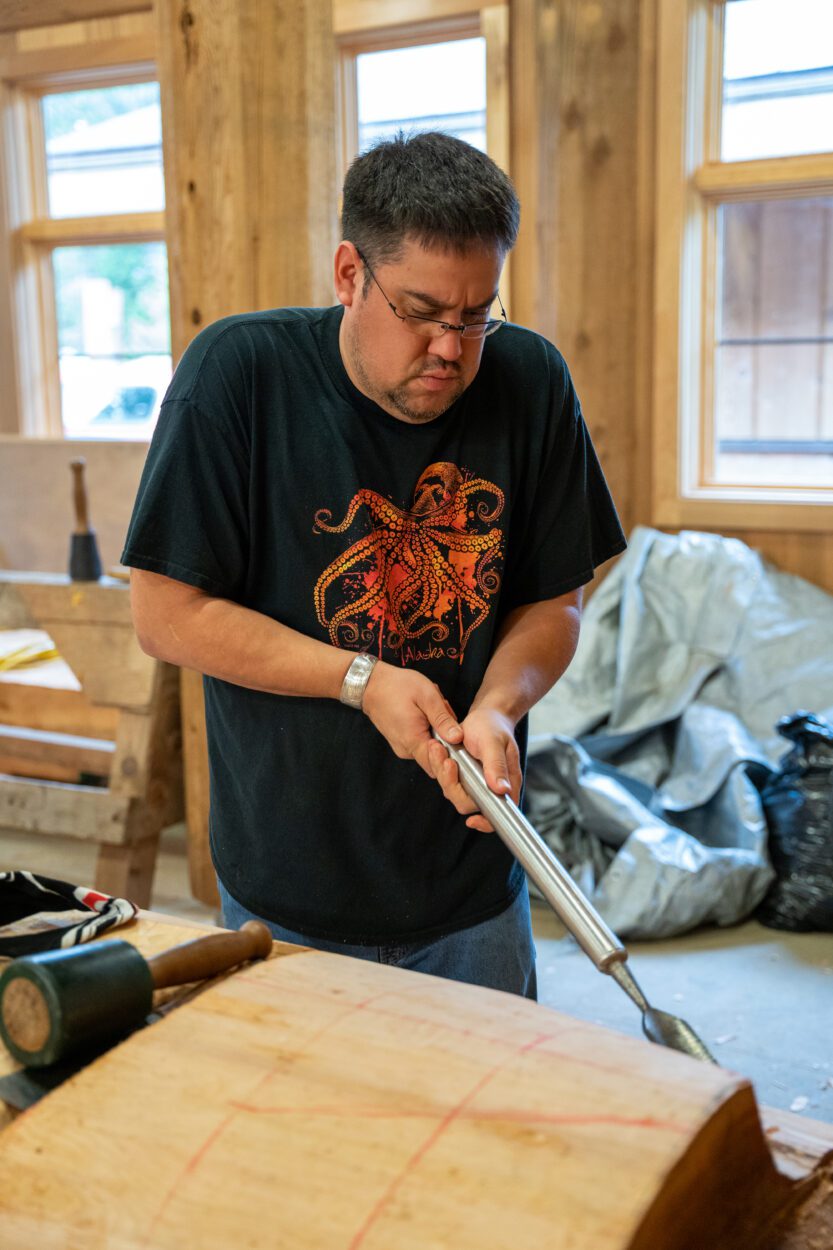
Norman Natkong works in the carving shed earlier this month. He is one of four apprentices working with Nathan Jackson and Jackson Polys. (KRBD photo by Eric Stone).
He said Jackson asked him to be an apprentice on the pole, and he was surprised, but agreed. He said it’s been a once in a lifetime chance.
Natkong said it hasn’t been easy to get where he is when it comes to carving. He noted having an ability to draw, and perfecting the various tools, is key.
“I’m just trying to take it all in as much as I can,” he commented.
Christian Dalton said working at the carving shed with the Jacksons is like coming full circle. Like Natkong, he used to give presentations at the shed, and has known the pair his whole life. Dalton is Teikweidi from Saanya Kwaan and was raised in Ketchikan.
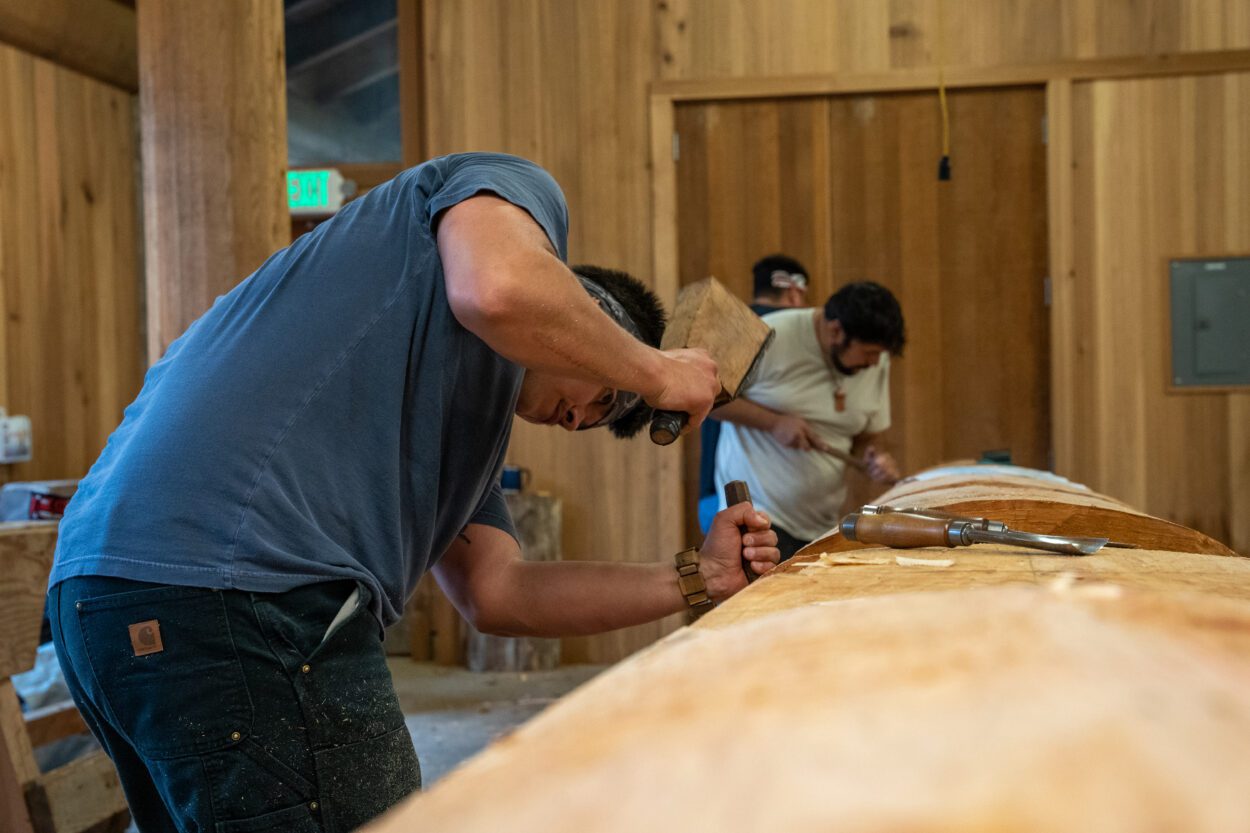
Christian Dalton carves a totem pole for the Totem Pole Trail. He is one of four apprentices working with Nathan Jackson and Jackson Polys. (KRBD photo by Eric Stone).
“It’s been fun. It’s something I always love to do,” he said. “And it just doesn’t feel like work. You know what I mean? You know, you wake up excited to go to work. It’s like that.”
He’s done some work with Polys before, and always came to Jackson for advice.
Dalton said he thinks the Juneau pole trail is a great idea.
“And I’m happy that, I guess you should say that Indigenous people have been working so hard,” Dalton explained. “Not just at the totem pole aspect, like I said, but to restore a culture.”
He said he’s inspired by all of Ketchikan’s artists.
The fourth apprentice working in Ketchikan is Tim Flanery. He was not present when KRBD spoke with Polys, Jackson, Took, Dalton and Natkong.
Raegan Miller is a Report for America corps member for KRBD. Your donation to match our RFA grant helps keep her writing stories like this one. Please consider making a tax-deductible contribution at KRBD.org/donate.
KRBD published the first part of this series, featuring carvers from Metlakatla and Prince of Wales Island, on Wednesday. A third story about the Totem Pole Trail project will be aired by KRBD in the future. The Sealaska Heritage Institute’s Totem Pole Trail — which will ultimately include 30 poles — will be installed on Juneau’s waterfront sometime next year.






